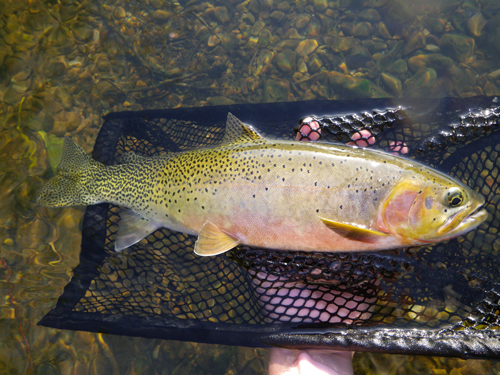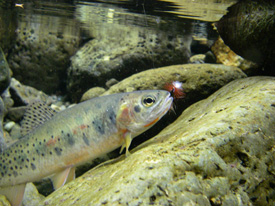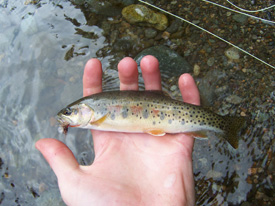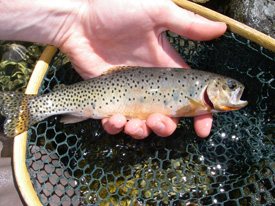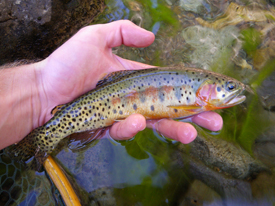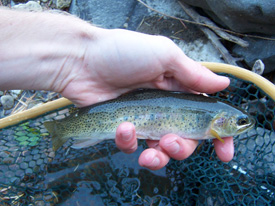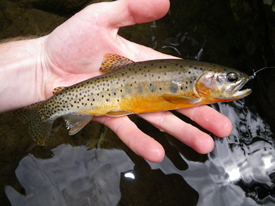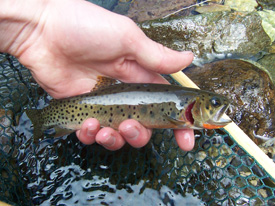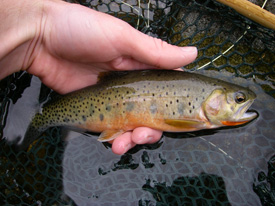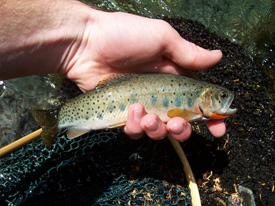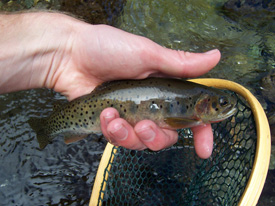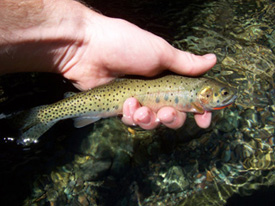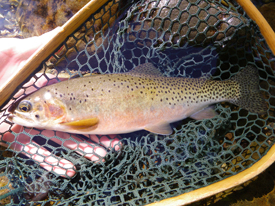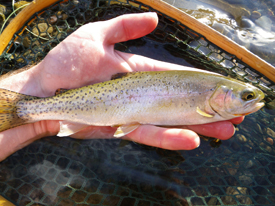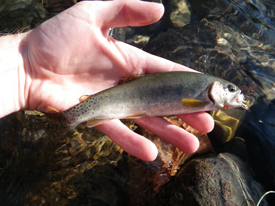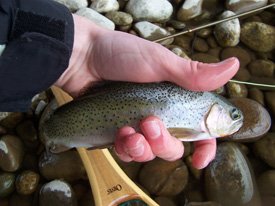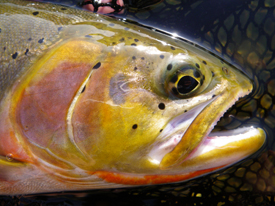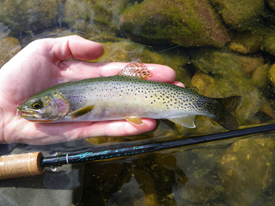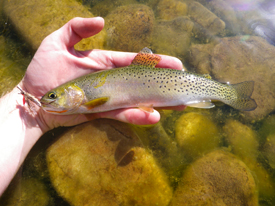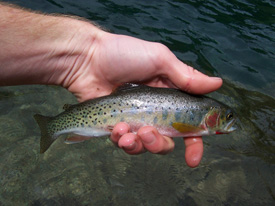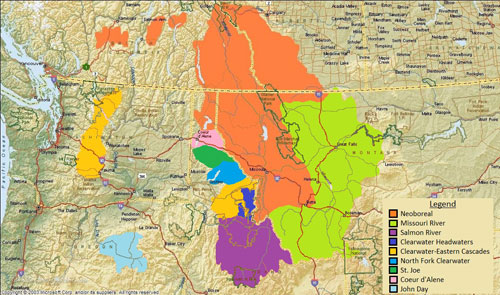Westslope Cutthroat Trout
Oncorhynchus clarki lewisi
A 16" fluvial Westslope cutthroat from a river in the Panhandle region of Idaho.
Introduction
The westslope cutthroat is one of the four major subspecies of cutthroat and is native to a very large area of western North America, including parts of Montana, Idaho, Wyoming, Oregon, Washington and Canada. Westslope cutthroat were first brought to the attention of the scientific community when Captain Meriwether Lewis of the Lewis and Clark expedition described trout caught by a member of the expedition near the Great Falls of the Missouri River in Montana on June 13th 1805. Naturalist George Suckley returned to this spot almost a half-century later and caught several westslope cutthroat on dry flies, which he named "Salar lewisi" in honor of Captain Meriwether Lewis (Behnke 2002). The common name westslope cutthroat came into use in later years and is a bit of a misnomer since these fish are found on both sides of the continental divide.
There has been much debate as to whether westslope cutthroat populations found along the eastern slope of the Cascade Mountains are native or not. Early reports document the occurrence of these fish in several river systems in the cascades, and the Washington Department of Fish and Wildlife (WDFW) has used westslope cutthroat from Twin Lakes in the Wenatchee River drainage as a brood stock for planting alpine lakes around the state since 1915. However the WDFW has long maintained that populations of these fish in the upper reaches of the Yakima River watershed were introduced, even though there are often no stocking records to support this. Recent studies have began to show that these populations are indeed native and have unique spotting patterns that are not found in other parts of their range (Trotter et al. 1998).
Life History Information
Westslope cutthroat exhibit lacustrine, fluvial and stream resident life history strategies. Historically most of the large lakes in the Upper Columbia River drainage supported lacustrine populations of westslope cutthroat. Most lacustrine populations migrate to inlet streams to spawn, but the population at Twin Lake in Washington is known to spawn in the lake's outlet stream and one isolated population in Alberta uses a shoal for spawning habitat (Trotter 2008). Spawning occurs between March and July and the first spawning typically when the fish are between four and five years old (Behnke 1992). Some populations make long migrations to reach their spawning grounds and fish from Flathead Lake are known to travel as far as 132 miles (Trotter 2008). Due to their life history lacustrine westslope cutthroat are not known to reach especially large sizes and appear to have a maximum size of about five pounds. This is mainly because they rarely prey on other fish, a behavior that this thought to be attributed to the fact that westslope have coevolved with two other highly predatory fish species, the bull trout and northern pikeminnow (Behnke 2002). Instead the majority of the westslope cutthroat's diet comes from zooplankton, and aquatic and terrestrial insects (Trotter 2008).
Fluvial and stream resident populations both spend their entire lives in flowing water. However the fluvial fish are born in headwater streams and migrate to larger rivers to feed and overwinter, while stream resident fish remain in the same stream that they were born in throughout their entire life. Adult fish spawn during the spring when runoff is the highest, and typically will hold off of creek mouths waiting for peak flows for up to two weeks (Scmetterling 2001). Once in their spawning stream the cutthroat appear to reside there for about a month, and repeat spawners do not appear to select the same spawning location as they choose on previous spawning runs. Westslope cutthroat are able to spawn more than once, but may experience a rather high mortality rate for post-spawning fish (Zurstadt and Stephan 2004). Once fall sets in these fish typically migrate downstream to deep pools with boulders in them, where they will overwinter and remain until the water temperatures warm up in March (Jakober et al. 1998). The maximum lifespan for fluvial westslope cutthroat appears to be eight years old (Fraley and Shepard 2005) Stream resident populations of westslope cutthroat typically occur in small headwater streams above barrier falls. These fish mature at ages of between two and five years of age and seven to nine inches long (Behnke 2002). Nanako et al. (1992) showed that in small streams containing both bull trout and westslope cutthroat, the cutthroat tended to be drift feeders while the bull obtained most of their food from the bottom. This study also showed that while the bull trout fed primarily on mayfly nymphs, the westslopes mainly utilized terrestrial insects as their food source.
Status
Westslope cutthroat in the lower 48 states have been displaced throughout much of their native range and today many populations are restricted to small headwater streams. Due to the dramatic decline of westslope cutthroat populations this fish was proposed to be listed as threatened under the Endangered Species Act (ESA) in 1997. Although this petition for the subspecies to be listed was declined, many populations remain at risk of extinction. Shepard et al. (1997) showed that in the Missouri River drainage westslope cutthroat occupy in less than 5% of their historic range and of the 144 remaining populations 71% were considered to be at a very high risk of extinction. The usual culprits for the decline of other types of inland salmonids can be blamed for the loss of many westslope cutthroat populations. The introduction of non-native fish, overfishing and habitat degradation have all played a major role in this drastic reduction of these fish from their historic abundance.
The introduction of non-native species has perhaps been the single greatest factor leading to the decline of the westslope cutthroat. Westslope cutthroat are impacted by introduced species by predation, competition and hybridization. In small streams introduced brook trout which hatch earlier than the cutthroat have a competitive advantage and often completely replace the native cutthroat. Shepard et al. (2002) showed just how much of an impact brook trout can have on westslope cutthroat based on a study done on a small stream in the Missouri River drainage. The population of westslope cutthroat in the creek consisted of only 80 individuals over three inches long for the entire stream reach in 1990, due to competition with brook trout. However between 1993 and 2000 the brook trout were removed and the westslope population increased to about 480 fish over three inches per mile of stream. According to Benhke (2002) the introduction of kokanee, lake trout and lake whitefish into the large lakes in the Columbia River watershed has led to a 90% or more decline in the westslope cutthroat populations inhabiting these lakes. Although some populations in the Columbia basin have coevolved with redband trout many populations were originally isolated from contact with rainbow trout and as such are susceptible to hybridization with these trout. Today only ten percent of the genetically tested populations of westslope cutthroat appear to be free of introgression with rainbow trout (Shepard 2003). Some of Montana's most famous rainbow and brown trout fisheries, such as the Madison, Gallitan, Big Hole, Missouri and Clark Fork Rivers were once home to thriving westslope cutthroat populations and show the extent to which these native trout have been impacted by introduced species. Even though the westslope cutthroat is nowhere near as abundant as it once was, there still are some strong populations in existence today and streams such as the South Fork of the Flathead River, MT and Kelly Creek, ID remain safe havens for these beautiful trout.
Description
Westslope cutthroat like any trout vary from one individual to the next, but there are a number of traits that generally set them apart from other cutthroat. The spots on westslope cutthroat tend to be concentrated on the posterior region of the body, as well as on the dorsal and caudal fins. According to Behnke (2002) if you were to draw an arc from the front of the anal fin to the pectoral fin, the majority of the spots would occur above this point. The spots tend to be smaller than those of the Yellowstone cutthroat and irregular shape. However the spots on westslopes from outlier populations in the John Day River drainage of Oregon and the eastern slopes of the Cascades in Washington may be as large as those found on Yellowstone cutthroat. Small stream resident or immature fish generally have nine to eleven bluish-purple colored parr marks along their lateral line. Their fins are a yellow to orange or peachy color. The cutthroat mark on these fish is a bright orange to crimson color and they typically have a purplish to orangish-red color on their gill plates. The coloration on the back of these fish is typically an olive or bronze color, that transitions to a greenish-gold color along the sides. Some fish may have reddish marks along their lateral line and sexually mature fish have orange bellies.
Stream Resident Form
Click on images to view a larger picture
Fluvial Form
Lacustrine Form
Contact
Feel free to contact me if you have any questions or comments
Native Trout Links
California Heritage Trout Challenge
Truchas Mexicanas' - Native Trout of Mexico
Balkan Trout Restoration Group
Trout and Seasons of the Mountain Village - About Japanese Trout
Fly Fishing Blogs
Dave B's Blog: Fly Fishing for Native Trout
The Search for Native Salmonids
Conservation Links
Western Native Trout Initiative
Fly Fishing Links
Fishing Art Links
Americanfishes.com - Joseph R. Tomelleri
